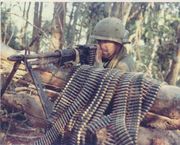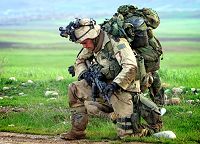The 173d Airborne Brigade (Separate) was born on 26 March 1963 on the Island of Okinawa and became the quick reaction force for the United States Pacific Command. While its lineage extends back to the World War I era, the operational concept and organization of a self-sustaining Airborne Brigade was unique to the Army force structure of the 1960’s. The core of the Brigade’s 1963 fighting elements included two battalions of the famed World War II 503d Parachute Infantry Regiment and the 3rd Battalion, 319th Artillery Regiment. They were supported by a 173d headquarters company, 173d Engineers, E Troop 17th Cavalry, The Casper Aviation Platoon, and Co D, 16th Armor.
From its birth through May 1965, the Brigade’s units underwent intense training both on the Island of Okinawa and with U.S. allies throughout the Pacific region. As a result of the Brigade’s frequent parachute jumps with allied airborne units, the Nationalist Chinese paratroopers named the Brigade paratroopers “Tien Bien" or "Sky Soldiers" a nickname that has stayed with the unit since its early existence.
In May 1965, the 173d Airborne Brigade deployed to Southeast Asia to support the embattled government of South Vietnam. The Brigade’s lead elements arrived in country on 5 May 1965, the first major United States Army ground combat unit committed to that long and bloody conflict. Shortly after the Sky Soldiers arrived in Vietnam, The First Battalion of the Royal Australian Regiment and the 161st Field Battery Royal New Zealand Artillery were attached to the Brigade.
In late June 1966, the Brigades’ combat power was enhanced by the addition of the 4th Battalion, 503d Infantry from Fort Campbell, and the 3rd Battalion, 503d Infantry joined the Brigade in September 1967. During it’s Vietnam deployment a number of smaller units were assigned to the Brigade including Co N, 75th Infantry (Ranger), the 39th Infantry Scout Dog Platoon, bringing its peak strength to more than 3,000 Sky Soldiers.
 The history of the Brigade’s operations in Vietnam includes a series of “firsts.” Its units were the first to go into War Zone D to destroy enemy base camps; it introduced the use of small long-range patrols, and conducted the only combat parachute jump in the Vietnam conflict on 22 February 1967. Sky Soldiers in 1967 blocked North Vietnamese Army attempts to cut South Vietnam into two pieces in some of the bloodiest fighting of the war. Brigade elements conducted an amphibious assault against enemy forces as part of an operation to clear the rice-growing lowlands along the Bong Song littoral.
The history of the Brigade’s operations in Vietnam includes a series of “firsts.” Its units were the first to go into War Zone D to destroy enemy base camps; it introduced the use of small long-range patrols, and conducted the only combat parachute jump in the Vietnam conflict on 22 February 1967. Sky Soldiers in 1967 blocked North Vietnamese Army attempts to cut South Vietnam into two pieces in some of the bloodiest fighting of the war. Brigade elements conducted an amphibious assault against enemy forces as part of an operation to clear the rice-growing lowlands along the Bong Song littoral.
During more than six years of continuous combat, the Brigade earned 14 campaign streamers and four unit citations. Sky Soldiers were awarded 13 Medals of Honor, 46 Distinguished Service Crosses, 1,736 Silver Stars and over 6,000 Purple Hearts. 1,647 Sky Soldiers assigned to the Brigade were killed. Units attached to the Brigade lost more than 165 warriors including 30 Australians and two New Zealanders. The Brigade’s combat mission ended on 14 January 1972; its units were inactivated at Fort Campbell, KY and its colors cased.
 The 173d Airborne Brigade was reactivated on 12 June 2000 in Vicenza, Italy, with one battalion (2-503) and became the European Command strategic response force. A second battalion, the 1st of the 508, was added in 2002 and its designation changed to 1-503 some months later. On March 26, 2003, the Brigade began a series of deployments in the Global War on Terrorism, making the largest mass combat parachute assault since WWII to open a northern front in support of Operation Iraqi Freedom. Nine Sky Soldiers fell during this one-year deployment.
The 173d Airborne Brigade was reactivated on 12 June 2000 in Vicenza, Italy, with one battalion (2-503) and became the European Command strategic response force. A second battalion, the 1st of the 508, was added in 2002 and its designation changed to 1-503 some months later. On March 26, 2003, the Brigade began a series of deployments in the Global War on Terrorism, making the largest mass combat parachute assault since WWII to open a northern front in support of Operation Iraqi Freedom. Nine Sky Soldiers fell during this one-year deployment.
In 2005, the Brigade entered Afghanistan in support of Operation Enduring Freedom VI. One Battalion Task Force was deployed along the Afghanistan-Pakistan border while the remainder of the Brigade deployed to Regional Command South. 17 Sky Soldiers fell during this one-year deployment.
In May 2007, an expanded 173d Airborne Brigade Combat Team deployed to Afghanistan in support of Operation Enduring Freedom VII. The unit returned to Europe in late July 2008. 43 Sky Soldiers died during the 15-month deployment and three warriors were awarded the Medal of Honor for gallantry.
In November 2009, the Brigade began a twelve-month deployment to Afghanistan in support of Operation Enduring Freedom X. They operated in Kunar, Logar and Wardak provinces. Nine Sky Soldiers fell during this deployment.
Sky Soldiers deployed to Afghanistan for a fourth time in June of 2012 again operating in Logar and Wardak provinces in support of Operation Enduring Freedom XIII. The Brigade returned home in February 2013. 14 Sky Soldiers died during this 9-month deployment. Subsequently, elements of the Brigade have deployed on numerous training missions with allied forces in the European Theater of operations. From 1913 to 1917, the 173rd Airborne Brigade successfully executed more than 27 multinational exercises and operations with more than 17 European countries. Sky Soldiers complemented their usual duties of training and building rapport alongside NATO Allies with serving as the U.S. Army Contingency Response Force in Europe.
Through international exercises such as Exercise Anakonda, the Brigade trained with more than 21 nations to demonstrate that the alliance and its partners are ready and capable to deal with any contingency. In addition, the 2nd Battalion, 503rd Infantry Regiment was the rotational force in Operation Atlantic Resolve, a multinational, U.S. led effort in Eastern Europe that demonstrated U.S. commitment to the unified security of NATO and dedication to enduring peace and stability in the region.
From 2013 to 2017, the 173rd Airborne Brigade successfully executed more than 27 multinational exercises and operations with more than 17 European countries. Sky Soldiers complemented their usual duties of training and building rapport alongside NATO Allies with serving as the U.S. Army Contingency Response Force in Europe.
